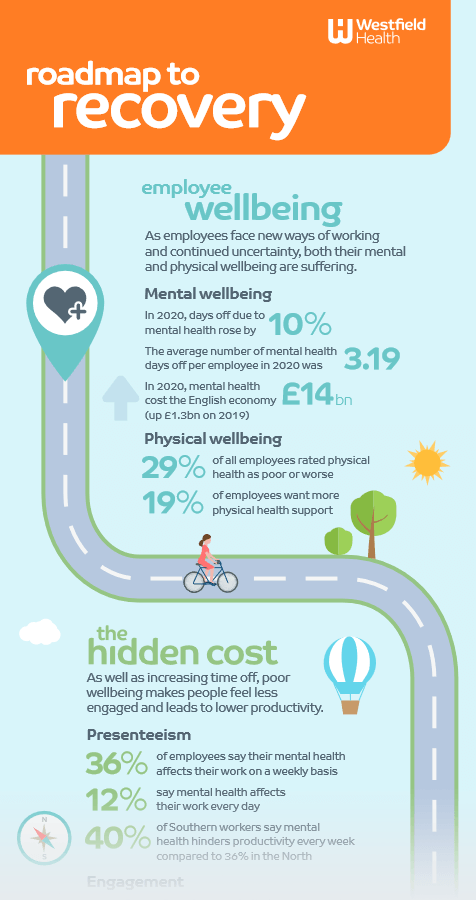Wellbeing at work is sometimes seen as a “nice to have” – a business expense rather than an investment. When budgets get tight, it’s often one of the first things to be cut. But businesses are overlooking a vital tool to boost recovery.
With this research, we set out to quantify the impact that wellbeing can have on business performance and employee productivity, as well as looking at the role that wellbeing could and should play in our recovery from the Covid pandemic.
The results were striking. Wellbeing has the potential to add billions to our national economy and to ease long-standing inequalities between regions. But it must be done right.
The three chapters explore the impact poor wellbeing has had on business results throughout the pandemic, the link between wellbeing and productivity and practical steps to help make the case for prioritising and investing in wellbeing in your organisation.
Key findings include:
- An estimated 320,000 businesses have underperforming wellbeing strategies.
- If wellbeing strategies reach their full potential, the increased productivity could add £61bn to the English economy by 2025.
- In organisations with a wellbeing programme in place, 43% of HR managers rated employee productivity as ‘very good’, compared to just 18% in organisations without one.
- Businesses in the North of England spend an estimated 17% less on employee wellbeing per head than the South.
Further research
Want to understand more about the pandemic’s impact on workplace wellbeing? Take a look at the first report in this series: Coping with Covid. As well as exploring the effects on mental and physical health, the report looks at how the pandemic has changed what employees expect from companies and provides managers with red flags to help identify and support those struggling with their mental health early.
Webinar – How to create a wellbeing culture and boost employee productivity
Watch our recent webinar where our experts share their advice on how wellbeing can support employees and improve productivity, how to make the business case for wellbeing and how to develop a wellbeing culture. Download the supporting factsheet.
What you’ll learn:
- The impact of Covid on businesses
- How wellbeing can support employees and alleviate issues such as poor productivity, presenteeism, absenteeism and stress.
- Putting a business case together for a wellbeing strategy that works
- How to nurture employee buy-in and develop a wellbeing culture
Infographic: The Roadmap to Recovery
The impact on the nation’s mental and physical health has been profound and the full extent of how long it will take to recover is still unclear. What is clear, however, is that where, when and how we work has been disrupted and is likely to be permanently altered due to the impact of Covid-19. The nation’s road to recovery, both social and economic, begins in the workplace, which makes the roadmap to reopening so important for businesses. The expectations and pressures on HR teams to think about employees’ mental and physical wellbeing will be intense throughout 2021 and beyond. That’s why, using findings from our Coping after Covid study, we have been able to map out key areas of focus for HR leaders when looking at their return to office or workplace reopening plans. The safe reopening of workplaces is of course the top priority – but this is only the beginning. There are four key areas of wellbeing to consider when plotting out the Roadmap to Recovery:- Employee mental and physical wellbeing
- The business impact of improving wellbeing
- The wellbeing solution for HR teams and businesses
- The business result of building an effective wellbeing programme


